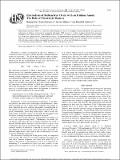Electrolysis of Molten Iron Oxide with an Iridium Anode: The Role of Electrolyte Basicity
Author(s)
Kim, Hojong; Paramore, James; Allanore, Antoine; Sadoway, Donald Robert
DownloadAllanore_Electrolysis of molten.pdf (1.157Mb)
PUBLISHER_POLICY
Publisher Policy
Article is made available in accordance with the publisher's policy and may be subject to US copyright law. Please refer to the publisher's site for terms of use.
Terms of use
Metadata
Show full item recordAbstract
Molten oxide electrolysis (MOE) is a carbon-free, electrochemical technique to decompose a metal oxide directly into liquid metal and oxygen gas. From an environmental perspective what makes MOE attractive is its ability to extract metal without generating greenhouse gases. Hence, an inert anode capable of sustained oxygen evolution is a critical enabling component for the technology. To this end, iridium has been evaluated in ironmaking cells operated with two different electrolytes. The basicity of the electrolyte has been found to have a dramatic effect on the stability of the iridium anode. The rate of iridium loss in an acidic melt with high silica content has been measured to be much less than that in a basic melt with high calcia content.
Date issued
2011-08Department
Massachusetts Institute of Technology. Department of Materials Science and EngineeringJournal
Journal of The Electrochemical Society
Publisher
Electrochemical Society
Citation
Kim, Hojong, James Paramore, Antoine Allanore, and Donald R. Sadoway. Electrolysis of Molten Iron Oxide with an Iridium Anode: The Role of Electrolyte Basicity. Journal of The Electrochemical Society 158, no. 10 (2011): E101.© 2011 ECS - The Electrochemical Society.
Version: Final published version
ISSN
00134651
1945-7111